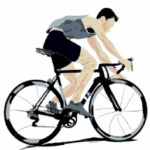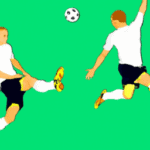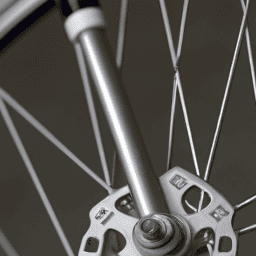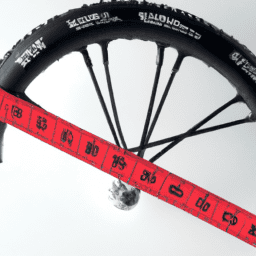Were you aware that annually, more than 100 million bicycles are manufactured? Given this significant quantity of bicycles available, it’s hardly shocking that learning how to expertly balance on a bicycle is a crucial skill to acquire.
Whether you’re a seasoned cyclist or just starting out, maintaining balance is crucial for a safe and enjoyable ride. Balancing on a bicycle may seem like a daunting task, but with practice and a few helpful tips, anyone can do it!
In this article, I’ll share some fundamentals of bicycle balance, tips for maintaining a steady speed and pedaling rhythm, and the importance of using proper gear. So, grab your helmet and let’s get started on the road to becoming a skilled cyclist!
Key Takeaways
- Maintaining balance on a bicycle is crucial for a safe and enjoyable ride.
- Center of gravity and counter steering are important for bicycle balance.
- Proper posture and consistent pedaling are essential for maintaining balance.
- Seeking professional coaching can improve cycling skills and build confidence.
Understand the Fundamentals of Bicycle Balance
You gotta understand the basics of bicycle balance if you wanna stay upright and ride with ease.
The first thing to understand is the center of gravity. Your body’s center of gravity is always shifting, so you need to be aware of it and adjust accordingly. When you’re cycling, your center of gravity should be over the bike’s wheels to maintain stability. If you lean too far to one side, you’ll lose balance and fall.
Another important aspect of bicycle balance is counter steering. This technique involves turning the handlebars in the opposite direction of the turn you want to make. It may seem counterintuitive, but it’s essential for maintaining balance at high speeds. To master counter steering, you’ll need to practice it until it becomes second nature.
Additionally, balance exercises and body positioning can help you maintain stability on your bike. Keep your body relaxed, and use your core to stabilize yourself.
With these fundamentals in mind, you’ll be ready to tackle the next step: maintaining a steady speed and pedaling rhythm.
Maintain a Steady Speed and Pedaling Rhythm
Maintaining a steady speed and pedaling rhythm is key to a smooth and enjoyable ride, even if you’re riding uphill or facing a headwind. Pedaling techniques play a crucial role in achieving this balance. It’s important to keep your pedaling consistent and smooth, avoiding sudden stops or jerky motions. This will not only help you maintain a steady speed, but also prevent unnecessary strain on your joints.
In addition to pedaling, paying attention to your body posture is essential in maintaining balance. Keep your upper body relaxed and shoulders down to avoid tension and stiffness. Maintain a slight bend in your elbows, as well as a neutral spine, to avoid putting too much pressure on your lower back.
With proper posture and consistent pedaling, you’ll find yourself gliding smoothly and effortlessly down the road. To continue improving your balance, it’s important to practice regularly. By doing so, you’ll build on the muscle memory that’s necessary to maintain a steady speed and rhythm.
With time and practice, you’ll find yourself able to tackle more challenging terrain and longer distances, making for a more enjoyable and fulfilling ride.
Practice Regularly
Practicing regularly is key to improving your cycling skills and achieving a smooth, enjoyable ride. Consistency in practice is important to help build muscle memory, improve balance, and increase endurance. To make the most out of your practice sessions, it’s important to set a regular schedule and stick to it. Whether you’re practicing alone or with a group, aim to ride at least three times a week. Start with shorter rides and gradually increase the distance and intensity over time.
Another benefit of group practice is the opportunity to learn from others and receive feedback. Riding with more experienced cyclists can help you improve your technique and provide motivation to push yourself further. Additionally, riding with a group can be more enjoyable and social, making it easier to stay committed to your cycling goals. Overall, practicing regularly and with a group can help you achieve better balance and control on your bike, making for a more enjoyable and safe ride.
To use proper gear, it’s important to invest in quality equipment and ensure that it is properly fitted to your body.
Use Proper Gear
When it comes to biking, I always make sure to use proper gear to keep myself safe and comfortable.
First and foremost, I choose a bike that fits me well. This is crucial for a smooth and efficient ride.
I also wear a helmet and other protective gear, such as gloves and knee pads, to prevent any injuries in case of a fall.
Lastly, using brakes and gears appropriately not only ensures safety but also helps me navigate different terrains with ease.
Choose a Bike That Fits You Well
To ensure a comfortable and safe ride, you should pick a bike that fits you properly. Proper bike sizing is crucial when it comes to balancing on a bicycle. A bike that is too big or too small can be difficult to control and balance. When choosing a bike, make sure the seat height is appropriate for your inseam length. You should be able to touch the ground with both feet while sitting on the saddle. Adjusting handlebars is also important to ensure proper fit. The handlebars should be at a comfortable height and distance from the saddle. This will prevent any strain on your back and arms while riding.
To further ensure a perfect fit, use the following table as a guide to determine the ideal bike size based on your height and inseam length:
| Height (ft) | Inseam (in) | Bike Size (in) |
|---|---|---|
| 4’10" | 24 | 13-14 |
| 5’0" | 25 | 13-14 |
| 5’2" | 26 | 15-16 |
| 5’4" | 27 | 15-16 |
| 5’6" | 28 | 17-18 |
Remember, choosing the right bike size can make a significant difference in your ability to balance and control the bike. Once you have found the right bike size, it’s time to focus on wearing the right gear for a safe ride.
Wear a Helmet and Other Protective Gear
Wearing a helmet and other protective gear is essential for safe bike riding, and did you know that wearing a helmet can reduce the risk of head injury by 85%? It’s important to choose a helmet that fits well and is snug on your head. The helmet should be worn level on your head and not tilted forward or backward. Make sure the straps are adjusted properly and fastened securely under your chin.
In addition to a helmet, it’s also recommended to wear other protective gear such as knee and elbow pads, as well as reflective clothing to increase visibility. Helmet safety and the importance of other protective gear cannot be stressed enough when it comes to bike riding. Not only can it prevent serious injury in case of an accident, but it can also give you peace of mind and confidence while riding. By taking these precautions, you’re not only protecting yourself but also setting a good example for others.
Now that you’re geared up and ready to ride, let’s discuss how to use brakes and gears appropriately.
Use Brakes and Gears Appropriately
Now that you’re all geared up, let’s talk about the essential bike skills you need to master to stay safe and upright on your bicycle. Aside from pedaling and steering, braking and gear shifting are two of the most important techniques to learn.
Proper braking techniques can mean the difference between a safe stop and a nasty spill, while gear shifting can help you maintain a comfortable pace and tackle hills with ease. To brake safely, always use both brakes together, and never just one at a time. Squeeze the brake levers gently at first, and then apply more pressure as needed.
If you have a bike with gears, it’s important to learn how to shift gears properly. Shifting to a lower gear makes pedaling easier, while shifting to a higher gear makes it harder. Start by using a lower gear when going uphill and a higher gear when going downhill. Don’t be afraid to experiment with different gear combinations until you find the right one for you.
With these braking techniques and gear shifting tips, you’ll be well on your way to mastering the art of bicycling. As you become more confident on your bicycle, you may want to try more advanced techniques, such as riding with no hands or executing tight turns. However, it’s important to remember that some skills require professional help to master.
If you’re struggling with a particular aspect of biking, don’t hesitate to seek out a qualified instructor or mentor. They can provide valuable guidance and support as you work to improve your skills and become a more confident cyclist.
Get Professional Help if Needed
If you’re struggling to balance on your bicycle, don’t hesitate to seek professional help. There’s no shame in admitting that you need assistance in mastering this skill.
In fact, getting coaching from a professional cycling instructor can offer many benefits. They can provide you with personalized guidance, tailored to your specific needs and abilities. They can also help you overcome any fears or anxieties you may have about cycling, and teach you how to navigate different terrains and weather conditions. With their expertise, you’ll be able to build your confidence and enjoy cycling to the fullest.
Coaching isn’t just for beginners, either. Even experienced cyclists can benefit from working with a professional instructor. They can help you fine-tune your technique and identify any bad habits that may be holding you back. They can also help you set and achieve new goals, whether that’s tackling a particularly challenging trail or improving your endurance.
So, if you want to take your cycling skills to the next level, don’t hesitate to seek out a professional coach. With their guidance and support, you’ll be able to become a better rider and enjoy all the benefits that cycling has to offer.
Frequently Asked Questions
What are some common mistakes people make when trying to balance on a bicycle?
As a cycling enthusiast, I’ve noticed common mistakes people make when trying to balance on a bicycle. Some tips for improvement include keeping your eyes forward, using your core muscles to stabilize, and practicing on a flat, open surface.
How can I tell if my bicycle is properly adjusted for my height and weight?
To ensure my bicycle is properly adjusted for my height and weight, I follow these adjustment tips: adjust the seat height, handlebar position, and pedal position. Additionally, I focus on maintaining proper weight distribution while riding.
What should I do if I feel like I’m losing my balance while riding?
If I feel like I’m losing my balance while riding, I should try practicing techniques like shifting my weight and keeping my eyes focused ahead. Building confidence is key, so starting with small, easy rides can help.
Are there any exercises I can do off the bike to improve my balance?
To improve balance off the bike, I recommend incorporating balance training exercises into your routine. Focus on developing core strength through planks, squats, and lunges. These exercises will improve overall stability and help you maintain balance while riding.
How can I stay motivated to continue practicing and improving my bicycle balance skills?
Staying motivated to improve bicycle balance skills requires consistency in practice. Set achievable goals, track progress, and reward yourself for milestones. Remember why you started and focus on the joy of riding.
Conclusion
In conclusion, balancing on a bicycle requires a combination of physical and mental skills. These include proper body positioning, steady pedaling, and focused concentration. Just like in life, maintaining balance can be challenging. But with regular practice and the right tools, it can be achieved.
Riding a bicycle is not just a physical activity, it’s symbolic of life’s journey. We must balance the different aspects of our lives, such as work, family, and personal growth. And just like how we use proper gear to ride a bicycle safely, we must also equip ourselves with the right tools and resources to navigate life’s challenges.
So let’s embrace the lessons that balancing on a bicycle teaches us and apply them to our daily lives. As we journey towards a balanced and fulfilling existence, we can achieve our goals by practicing these skills.
















